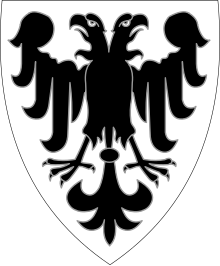This is an old revision of this page, as edited by 93.86.180.197 (talk) at 13:42, 5 January 2025. The present address (URL) is a permanent link to this revision, which may differ significantly from the current revision.
Revision as of 13:42, 5 January 2025 by 93.86.180.197 (talk)(diff) ← Previous revision | Latest revision (diff) | Newer revision → (diff)
The Olgovichi or Olhovychi were collateral branch of the large Rurik dynasty and one of the four dominant princely clans of Kievan Rus' in the 12th and 13th century. First mentioned in the Hypatian continuation of the Primary Chronicle (PVL) under the year 1116 and literally meaning "the sons of Oleg", they were named after a Oleg I Sviatoslavich, Prince of Chernigov (r. 1094–1097) and Prince of Novgorod-Seversk (r. 1097–1115).
Overview

The Principality of Chernigov (modern Chernihiv in northern Ukraine) was the main Olgovichi patrimony (hence the term "Olgovichi of Chernigov"), with the Principality of Novgorod-Seversk (modern Novhorod-Siverskyi) serving as the primary appanage. From 1054 to 1186, the Principality of Murom–Ryazan was subordinate to the Olgovichi of Chernigov; then it sought an independent existence between Chernigov and Suzdalia until Vsevolod the Big Nest destroyed and depopulated Ryazan in 1208.

The Olgovichi frequently managed to put one of their clan members on the grand princely throne of Kiev (modern Kyiv), including Michael of Chernigov, who in the wake of the Mongol invasion was executed by Batu Khan in 1246 and later canonised as an Orthodox saint. There is some uncertainty regarding his descendants, who from the late 13th century appear to have expanded Olgovichi control to Bryansk, Kursk, and the Upper Oka Principalities (in the present-day Russian Federation). From 1301 to 1324, the Olgovichi reigned in Kiev again. In the 14th and 15th centuries, the Olgovichi principalities were gradually divided between the Grand Duchy of Lithuania (where the clan was incorporated into the Ruthenian nobility) and the Principality of Moscow. Slovenian–Canadian Slavistics researcher and priest Martin Dimnik (1941–2020) has published extensive studies on the Olgovichi.
Many Russian princely families have descended from this branch of the Rurik dynasty, such as: Dolgorukov, Baryatinsky, Gorchakov, Obolensky, Odoyevsky, Volkonsky, Oginski, Massalski, Repnin etc.
Notes
- Old East Slavic: Опьговичи, romanized: Ol'govichi; Ukrainian: Опьговичі, romanized: Ol'hovychi; Russian: Опьговичи, romanized: Ol'govichi. Literally "sons of Oleg / Oleh".
- In 12th- and 13th-century Kievan Rus', the four dominant princely clans were the Olgovichi of Chernigov, the Rostislavichi of Smolensk, the Iziaslavichi of Volhynia (based in modern Volodymyr in Volyn'), and the Yurievichi of Suzdalia (alias the Vsevolodichi of Vladimir on the Klyazma). 'Three of these clan founders – Vsevolod, Rostislav, and Iziaslav – were the grandsons of Volodimer Monomakh. The outlier from this set is Oleg, who was instead a cousin of Volodimer Monomakh.'
- "Volodimer', trusting in God and in justice, went to Smolensk" "with his army and with Davyd Sviatoslavich, and the Olgovichi."
References
- Raffensperger & Ostrowski 2023, pp. 116–117.
- Raffensperger & Ostrowski 2023, p. 117.
- Thuis 2015, p. 221.
- Makhnovets 1989, p. 175.
- Martin 2007, pp. 101, 107, 116, 119, 124, 132, 133, 145, 498.
- Raffensperger & Ostrowski 2023, p. 72.
- Raffensperger & Ostrowski 2023, p. 85.
- Raffensperger & Ostrowski 2023, pp. 85, 120.
- ^ Raffensperger & Ostrowski 2023, p. 109.
- Raffensperger & Ostrowski 2023, p. 120.
- Raffensperger & Ostrowski 2023, pp. 138, 147.
- https://russiannobility.org/princes-of-the-russian-empire/
Bibliography
Primary sources
- Makhnovets, Leonid (1989). Літопис Руський за Іпатським списком [Rus' Chronicle according to the Hypatian Codex] (in Ukrainian). Kyiv: Dnipro. p. 591. ISBN 5-308-00052-2. Retrieved 18 July 2024. — A modern annotated Ukrainian translation of the Primary Chronicle, Kievan Chronicle and Galician–Volhynian Chronicle, based on the Hypatian Codex with comments from the Khlebnikov Codex.
- Thuis, Hans (2015). Nestorkroniek. De oudste geschiedenis van het Kievse Rijk (in Dutch). Nijmegen: Uitgeverij Vantilt. p. 304. ISBN 9789460042287. – A modern Dutch translation of the Primary Chronicle, including the Hypatian continuation.
Literature
- Dimnik, Martin (1994). The Dynasty of Chernigov, 1054–1146. Pontifical Institute of Mediaeval Studies. ISBN 0-88844-116-9.
- Martin, Janet (2007). Medieval Russia: 980–1584. Second Edition. E-book. Cambridge: Cambridge University Press. ISBN 978-0-511-36800-4.
- Raffensperger, Christian; Ostrowski, Donald (2023). The Ruling Families of Rus: Clan, Family and Kingdom. London: Reaktion Books. p. 309. ISBN 978-1-78914-745-2. (e-book)